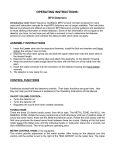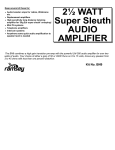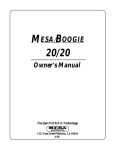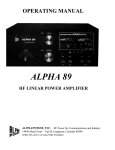Download Cadence CXR-7 Specifications
Transcript
CXR-7 3 WAY ELECTRONIC CROSSOVER // OWNERS MANUAL CONTENTS • Specifications 3 • Features 4 • Controls, Indicators, and Terminal 5-8 • Installation • Final System Check • Troubleshooting Guide 9 - 10 11 12 2 SPECIFICATIONS Power Source: Input Current: Distortion: Frequency Response: S/N Ratio: Separation: Crossover Frequencies (Continuously Variable) Front High-Pass, X1: X2: Rear High-Pass: Subwoofer: Crossover Slope Rate Low-Pass: High-Pass: Subwoofer Boost: Input Impedance: Output Impedance: Output Gain: Output Voltage Level: Dimensions: 3 14.4 Volts DC negative Ground 0.5 Amp Max 0.01% THD @ 1 Volt Output Level 10Hz - 30Hz (-3dB) 95dB 60dB 25 - 400Hz 500 - 8000Hz 25 - 400Hz 25 - 400Hz 18dB per Octave 3rd Order Butter Worth 12dB per Octave 3rd Order Butter Worth Single Octave 0dB to 12dB (Variable) at 45Hz 20K Ohms 100 Ohms 1:2 (+6dB) 7 Volts Max 5.5"(W) x 7.5"(L) x 1.75"(H) FEATURES • EXCLUSIVE INFINITE CROSSOVER DESIGN • PARALLEL INPUT SWITCH • ASYMMETRICAL ELECTRONIC CROSSOVER DESIGN For a source unit having a single pair of signal outputs an adapter is needed to split the source signal for the front and rear inputs. With the mobile electronic crossover, by engaging the parallel input feature, an external adapter is no longer necessary. • BASS BOOST CIRCUITRY WITH QUASI-PARAMETRIC EQUALIZATION • FRONT/REAR INPUTS WITH FRONT/REAR/ SUBWOOFER OUTPUTS A sealed enclosure causes a woofer’s frequency response to roll off at a rate of 12dB per octave below the enclosure’s resonant frequency. The bass boost circuitry’s quasi-parametric equalization provides a single octave boost of 12dB at 45Hz to ensure smooth and accurate bass response. The mobile electronic crossover features front and rear preamp inputs with front and rear outputs as well as constant subwoofer output that is independent of the front/rear fader control on the source unit. • ADJUSTABLE OUTPUT LEVEL • DC/DC REGULATED SWITCHING POWER SUPPLY This power supply design provides constant voltage to the crossover regardless of the battery’s voltage to ensure consistent output performance at all times. This design also eliminates switching noise sue to voltage fluctuation. • STEREO/MONO SUBWOOFER • GOLD PLATED RCA CONNECTORS • FREQUENCY MULTIPLIER The front high-pass section is equipped with frequency multiplier switch that can be used to multiply the crossover frequency points. With the additional selectable crossover points system setting becomes an art of precision. FEATURES AND SPECIFICATIONS SUBJECT TO CHANGE AND OR IMPROVEMENT WITHOUT NOTICE 4 CONTROLS, INDICATORS, and TERMINALS CXR-7 5 1. POWER INPUT TERMINAL (RED) This wire should be connected to the positive terminal of your vehicle battery or other constant +12V source. 2. GROUND INPUT TERMINAL (BLACK) This wire should be connected the vehicle’s chassis. Ensure that you have a good connection. When connecting the wire make sure that there is no paint or other insulator blocking the connection. 3. REMOTE TURN ON INPUT TERMINAL (ORANGE) This wire should be connected to the remote turn on wire or antenna lead of the source unit. Should your system not have any turn on leads, you can wire the remote terminal to an accessory lead which turns on with your car’s ignition. 4. POWER INDICATOR “OUT”: If the source unit has independent front and rear channel outputs disengage the parallel input by sliding the switch to the “out” position. 7. LEFT/RIGHT REAR CHANNEL SIGNAL INPUTS Connect to the rear channel output of the source unit. MAKE SURE THAT THE PARALLEL INPUT SWITCH IS AT THE “OUT” POSITION! 8. LEFT/RIGHT MIXED IN/OUT TERMINALS AS INPUT TERMINAL: Connect to the subwoofer output of the source unit. AS OUTPUT TERMINAL: If running a multi cross-over system, connect to the front channel input terminal of the next electronic crossover. This LED lights up when the internal switching power supply is activated and the unit is operational. 9. FRONT CHANNEL HIGH-PASS FREQUENCY SELECTOR 5. LEFT/RIGHT FRONT CHANNEL SIGNAL INPUTS Used to select the front channel high-pass crossover frequency between 25Hz and 400Hz (or 500Hz and 8K Hz when its frequency multiplier is in the “x20” position. To be connected to the front channel output of the source unit. 6. PARALLEL INPUT SWITCH “IN”: When the parallel input is in this position, the input signals coming through the front channel signal inputs are split and directed to the front rear channels simultaneously (this feature is to be used when the source unit has no separate front, rear, or subwoofer outputs). 10. REAR CHANNEL HIGH-PASS FREQUENCY SELECTOR For selection of rear channel high-pass crossover frequency between 25Hz and 400Hz. 6 CONTROLS, INDICATORS, and TERMINALS 11. FRONT CHANNEL HIGH-PASS FREQUENCY MULTIPLIER 17. LEFT/RIGHT FRONT CHANNEL OUTPUT TERMINALS Positioning this switch at the “x20” position changes the range of selectable crossover frequency for the front channel high-pass from 25Hz - 400Hz to 500Hz - 8K Hz. Connect to the front channel amplifier left/right inputs. 12. SUBWOOFER FREQUENCY SELECTOR Allows you to set the low-pass crossover frequency for the subwoofer channel between 25Hz and 400Hz. 13. BASS SHAPER BOOST SWITCH When activated this circuit provides a single octave boost of 12dB at 45Hz to equalize the woofer enclosure. 14. PHASE INVERTER Placing the switch at the “180” position shifts the subwoofer output’s signal 180° out of phase relative to the front and rear output signals. 15. SUBWOOFER STEREO/MONO SWITCH For selection of stereo or mono mode subwoofer output. 16. FRONT CHANNEL OUTPUT LEVEL CONTROL For adjusting the front channel output signal level. 7 18. REAR CHANNEL OUTPUT LEVEL CONTROL Used to adjust the rear channel output signal level. 19. LEFT/RIGHT REAR CHANNEL OUTPUT TERMINALS Connect to the rear channel amplifier left/right inputs. 20. SUBWOOFER OUTPUT LEVEL CONTROL Used to adjust the subwoofer channel output signal level. 21. LEFT/RIGHT SUBWOOFER OUTPUT TERMINALS Connect to the subwoofer channel amplifier left/right inputs 22. SUBWOOFER OUTPUT LEVEL REMOTE CONTROL TERMINAL AMPLIFIER WIRING DIAGRAMS Four-Channel “bi-amp” system (stereo front/rear) Two-Channel “tri-amp” system S CXR -7 CXR-7 8 INSTALLATION CROSSOVER TERMINAL CONNECTED TO TERMINAL Left/right front inputs Source unit Front pre-amp outputs Left/right rear inputs Source unit Rear pre-amp outputs Left/right mixed in/out (as input) Source unit Subwoofer pre-amp outputs Left/right mixed in/out (as output) Another compatible electronic crossover Front inputs Left/right front outputs Front amplifier Left/right inputs Left/right rear outputs Rear amplifier Left/right inputs Left/right subwoofer outputs Subwoofer amplifier Left/right inputs Power input terminal (b+) Battery Positive terminal Ground input terminal (gnd) Vehicle chassis Bare metal spot Remote turn-on input terminal Source unit Remove control wire or power antenna lead 9 ELECTRICAL WIRING DIAGRAM Electrical wiring diagram CXR -7 10 FINAL SYSTEM CHECK 1. Pre-Setting A. Set front, rear and subwoofer amplifier input gain to half of their maximum. B. Preset the crossover frequencies and output levels as follows. Bi-Amp System Front frequency selector: Frequency multiplier: Rear frequency selector: Subwoofer frequency selector Front output Rear output Subwoofer output level 160Hz X1 160Hz 160Hz 10 o’clock position 10 o’clock position 12 o’clock position Tri-Amp System Front frequency selector: Frequency multiplier: Rear frequency selector: Subwoofer frequency selector Front output Rear output Subwoofer output level 200Hz X 20 120Hz 120Hz 10 o’clock position 10 o’clock position 12 o’clock position C. Preset the volume of the source unit to its minimum (otherwise, when the source unit is tuned on, the sudden surge of high power from the amplifier might cause damage to the audio components. 11 2. Turn the source unit on and slowly turn the volume up: A. If no sound at all: i) Turn the system off immediately. ii) Check all connections (refer to page 9 for details). iii) Use a volt/ohm meter to check your ground connections. iv) Check your power input, ensure that it is properly connected to the positive terminal of a 12V power source. v) Check to see that the remote on/off terminal is connected properly to a +12V source. vi) If everything is on order try turning the power off and then on again. If problem persists, refer to the trouble shooting guide on the next page for assistance. B. Obvious distortion: Turn the system off and refer to the trouble shooting guide on the next page. C. Out of phase problem (i.e. Abnormal Bass): Turn the system off and refer to the trouble shooting guide on the next page. 3. NOISE CHECK Before mounting the mobile electronic crossover and the other audio components permanently, please conduct the following noise check: 1. Start the engine and turn on source unit. 2. Rev the engine and vary the audio volume to check for radiated engine noise. If there is an alternator whining noise or “tic-tic” noise, refer to the trouble shooting guide on the next page. If the problem persists consult your local retailer/installer for assistance. 3. If no unwanted noise is detected, double check all wiring and cables to ensure safe placement. Then securely tighten the mounting screws of the unit. TROUBLE SHOOTING GUIDE SYMPTOM PROBABLE CAUSE 1. No power. • Check all the ground, B+ and remote terminals for tight connection. • Check all fuses. • Use a volt/ohm meter to check all power wire connected to see if the system is receiving +12V. 2. “Motorboating”: the unit power indicator going off repeatedly when the audio system is on. • Check if the unit B+ power input is connected to directly to a +12V power source. • Check the battery voltage. If low, recharge or replace it. • Check if the unit has a good ground connection. 3. The unit heats up quickly even when the audio system is at moderate volume. • Check all ground connections. • Check for speaker short. 4. When the engine is running the audio system has a whining noise that remains unchanged or disappears with the increase of audio volume. • Check all power wires and ensure that they are connected to a +12V power source. • Check all ground connections. • Check if the source unit and the mobile electronic crossover are grounded at the same reference point. 5. When the engine is running, the audio system has a whining noise that increases or decreases with the volume of all sources (radio, CD, or MP3). • Install a 10 amp in-line filter on the red power wire of the unit. • If whining persists, check the alternator diodes and the voltage regulator. 6. When the engine is running, the audio system has has a whining noise that increases or decreases with the CD/MP3 mode ONLY. • This is commonly known as “radiated” noise. It is not caused by the unit and thus is beyond the scope of this manual. Please contact your local retailer/installer for assistance. 7. Obvious distortion at low volume. • Output level of various channels not compatible, refer to FINAL SYSTEM CHECK on the previous page. 8. Over all sound effect good, but bass is abnormal (more bass at the two extreme settings of the balance control that at the center setting). • The subwoofers are “out-of-phase” with each other thus cancelling the bass when the balance control is at the center position. Check the wiring from the amplifier to the subwoofers (positive [+] and negative [-] to negative [-]). 12 // Features and specifications subject to change and or improvement without notice. Though we tried our best to ensure that this manual is free and clear of errors please don’t hold us responsible for printing errors. // www.cadencesound.com

























